Partners
Philippine Community Fund
http://www.p-c-f.org/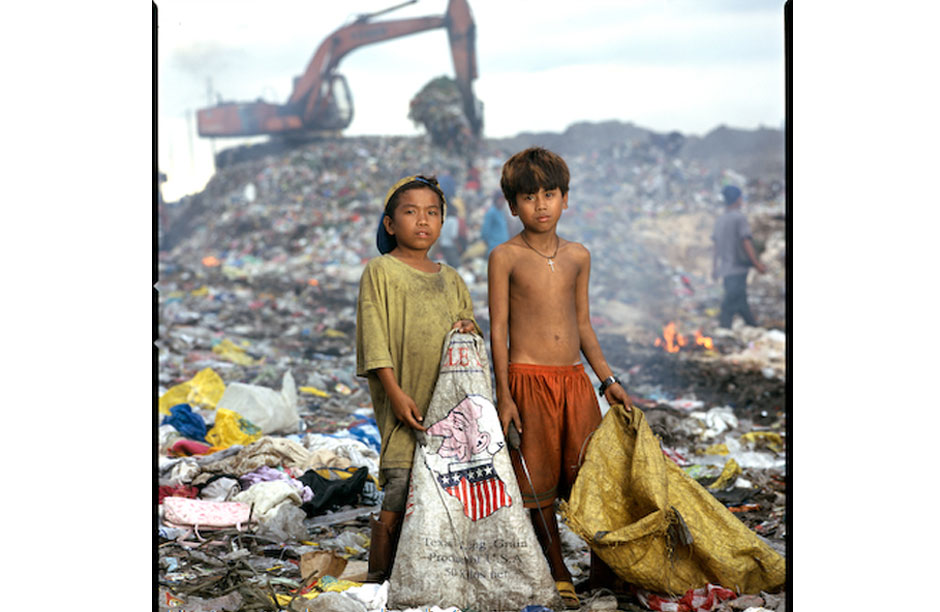 The "Smokey Mountain" waste site outside of Manila in the Philippines is a notoriously grim place where children (like these two young boys) could be seen on a daily basis sifting through garbage searching for items for reuse or resale. Image by photographer Harmut Schwazbarch, 2006.
The "Smokey Mountain" waste site outside of Manila in the Philippines is a notoriously grim place where children (like these two young boys) could be seen on a daily basis sifting through garbage searching for items for reuse or resale. Image by photographer Harmut Schwazbarch, 2006.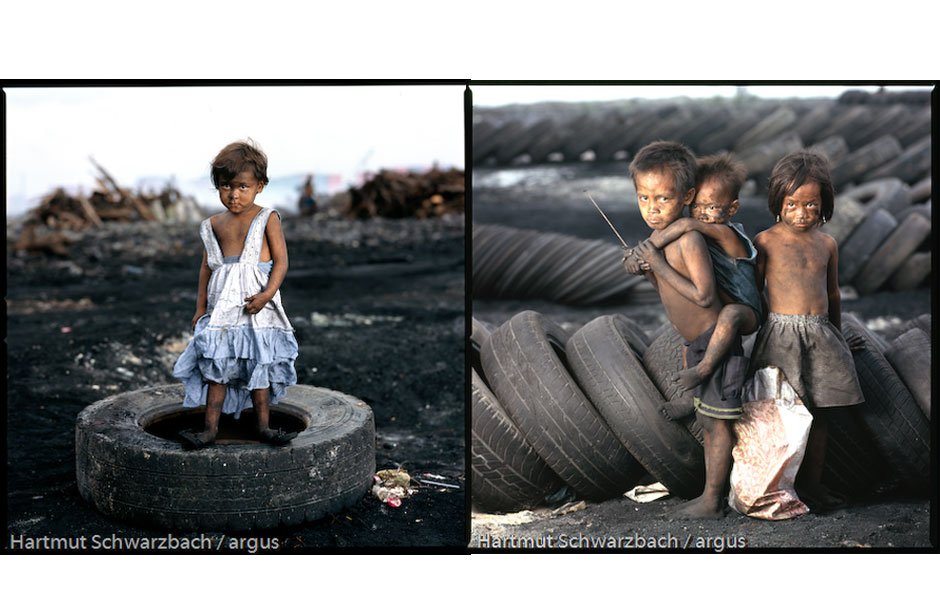 Both images (2006) by photographer Harmut Schwazbarch who received an award from UNICEF for his series on children working on the "Smokey Mountain" waste site outside of Manila in the Philippines.
Both images (2006) by photographer Harmut Schwazbarch who received an award from UNICEF for his series on children working on the "Smokey Mountain" waste site outside of Manila in the Philippines.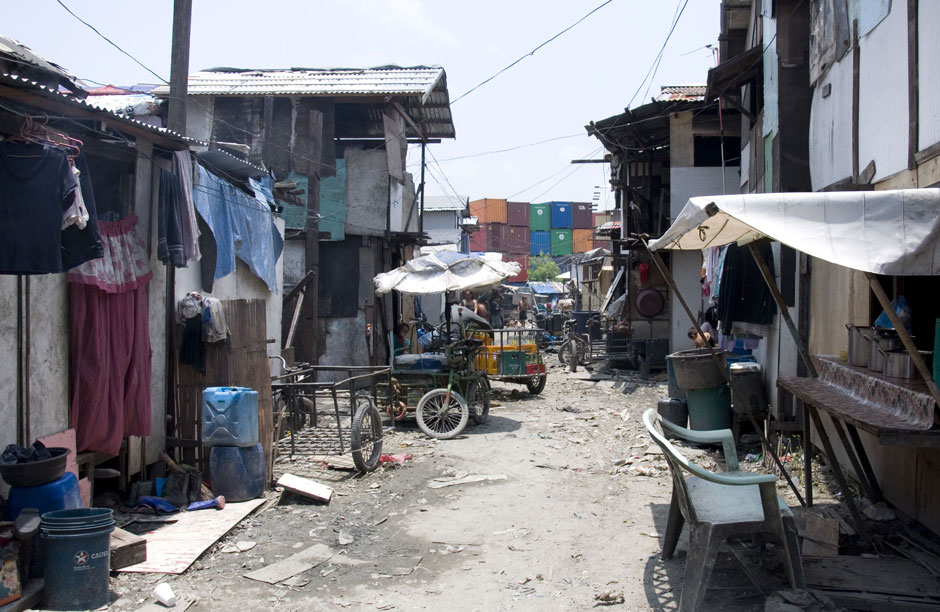 Inside the shanty village near Manila where most of the children who were sent out to collect reusable waste on "Smokey Mountain" live.
Inside the shanty village near Manila where most of the children who were sent out to collect reusable waste on "Smokey Mountain" live.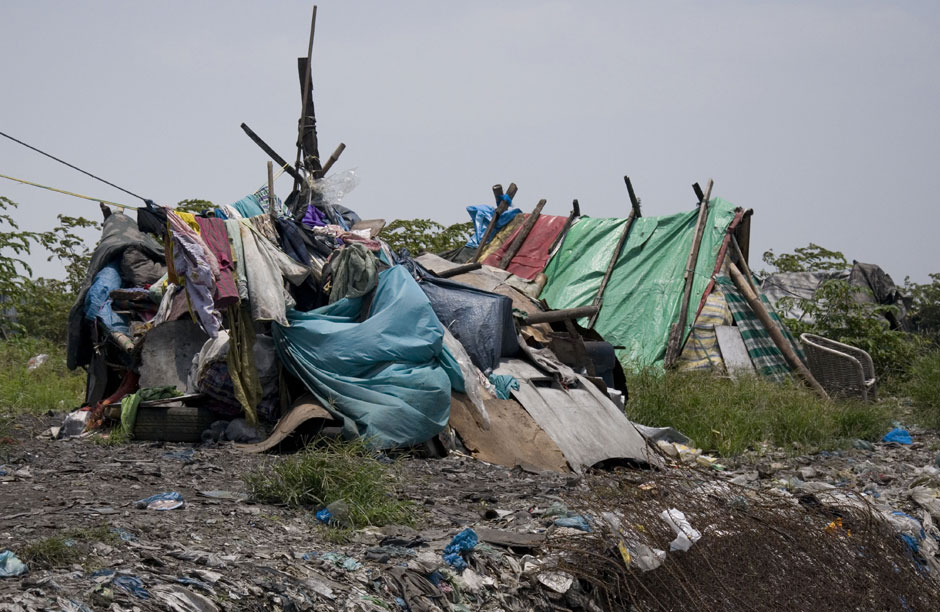 A tent-dwelling built directly on the Smokey Mountain waste site.
A tent-dwelling built directly on the Smokey Mountain waste site.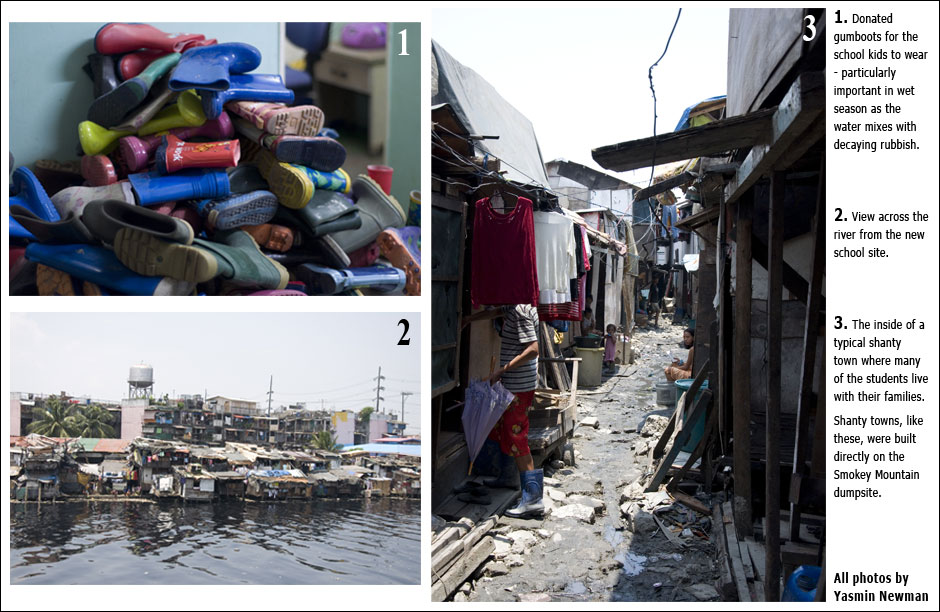
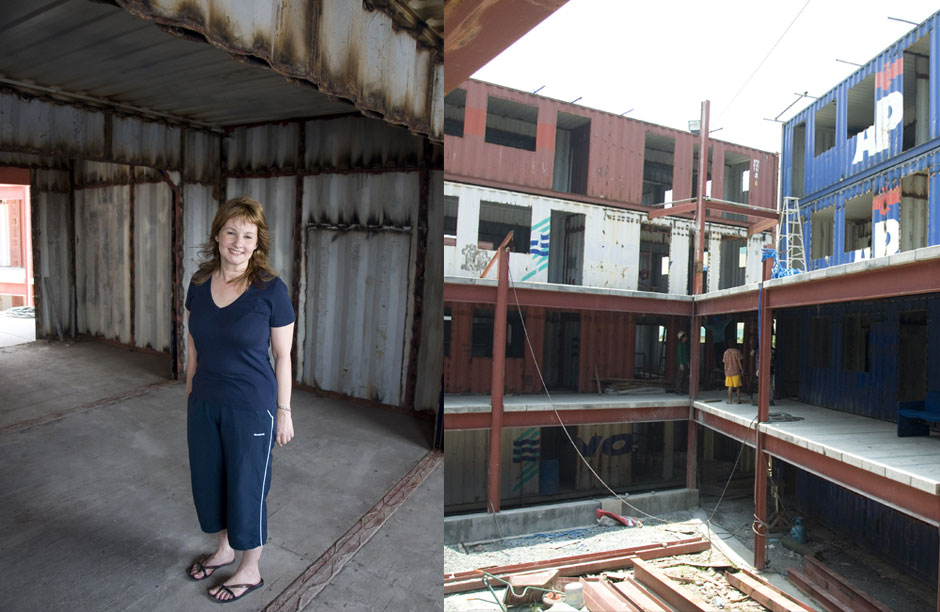 Left: Jane Walker standing in the construction site for the new school - set to be the largest school worldwide made out of shipping container. Right: The interior of the school under construction.
Left: Jane Walker standing in the construction site for the new school - set to be the largest school worldwide made out of shipping container. Right: The interior of the school under construction. photo by Jasmine Newman
photo by Jasmine Newman
Sorting Through the Mess of Child Labor
By Yasmin NewmanA case study from the shores of Manila Bay
According to the International Labor Organisation (ILO), one in six children worldwide is engaged in some form of child labor. That’s 250 million children somewhere in the world between the ages of 5 and 14, stripped of their basic rights as a human being – those ratified by the United Nations and those to simply be human – to be a child. Around the planet, these children can be found toiling arduously in a mine in South Africa, sitting on bare floors weaving rugs in India, separated from family and friends as domestic labor in Brazil, or sold off into slavery and forced into prostitution in Russia. These are but a few examples, the list being long, and the countries often interchangeable. The number, no doubt, masking countless others, undisclosed by parents fearful that the illegal nature of their work will be found out, or already quietly, shamefully, ignored by governments too shallow in tenacity to take action, or limited in resources to do so.
The statistics are frightening, the stories heartbreaking. Yet, to dismiss it as such is to contribute to the problem, as is denying our own part in current consumer culture that drives most of it. How much did your last pair of sweat pants cost you for example, and how willing would you be to pay double? Some would suggest a sweeping legal ban, as if simple, without recognizing the intricacies of the problem (like the positive effects of child labor and the difficulties in regulating such a ban) as well as an acknowledgment of the differing nature of child work across different countries. This too would be naïve. Clearly, the dilemma of child labour is complex and where much of the negative impact is immediately observable, a large proportion can take years to manifest.
Sadly, child labour still exists in both developed and developing nations. Unsurprisingly, it is most prevalent in the developing world, the region accounting for 98% of all child workers. According to ILO data, Sub-Saharan Africa has the largest proportion of working children – about one third – with the majority of these in the agriculture sector. The largest total figure however, is from the Asia Pacific, where our story will take us, with around 127 million children caught in a tangle of which they have no control.
On the shoreline of Manila Bay, in the steaming capital of the Philippines, a young child smiles. She could easily choose not to; by our standards, living in squalor – literally in trash – on a dumpsite near the once infamous Smokey Mountain, her situation is bleak. In its prime, Smokey Mountain – a large landfill consisting of over two million tons of waste and home to around 30,000 squatters – plummeted the Philippines and the living conditions of its poor to worldwide lows until the government, under pressure by international human rights lobbyists, tore it down. Yet with little (that is, long-lasting) infrastructure provided for the displaced rubbish dwellers, the move did not do much to alleviate the problem and today, makeshift homes on dumps surrounding the old site still exist in great numbers, like the young girl’s, where families camp to make a living sorting rubbish the only way they know how.
Yet the little girl smiles because something in her life has changed – she now has hope. She might not recognize it as such, or the shift, but it is there nevertheless, a feeling her parents born into the same unforgiving, unrelenting cycle lost years ago. Interestingly, with transformations in their daughter’s situation, they too are beginning to hope for a brighter future. And this, you’ll see, is half the battle.
It had been six years since I last visited the Philippines, but this being the first time on my own. Born in Australia to an Aussie father and Filipino mother, I’d been lucky to grow up spending month long holidays in the Philippines every two to three years, time for my brother and I to develop a connection with the country and culture of my mother. But, like many children of two worlds, I wanted more – more time, greater understanding. Interestingly as a food writer, I had both the perfect vehicle to explore it, and a means to share with others what I’d learnt. So I set off for six months to research a cookbook on the Philippines and uncover its secrets through mouthfuls of native cuisine.
With food at its heart, I traveled the country from north to south, sharing meals with great chefs, enjoying local delicacies prepared by street vendors and spending time eating, laughing and bonding with my family, just as Filipinos do. I learnt a lot and the book, now having returned home to Australia, is coming together with incredible adventures held within. Amidst all the good times, however, was the pervading sense of disparity I continually observed and felt. Poverty, it’s everywhere there and heartbreaking in clarity.
Hearing wind of Smokey Mountain (smelling it, some would say) I knew this was a story that needed to be told – and must in return for what I’d experienced. And perhaps also, who else would? Like the country and its cuisine, little is known about the Philippines and the plight of its people, and in particular, child labor as it exists there. Yet, more than simply close to my heart, as a case study, Smokey Mountain illuminated some truly valuable points that I had never previously considered. Was it fate that for a food writer, I discovered that food was at the heart of this issue? I think not, rather, that food has always been part of the problem, yet so basic that we often fail to see it. In the Philippines however, a country where customs, culture, life and love is woven inexorably through food, it smacks you right in the face.
In 1995, a British newspaper distribution manager, Jane Walker, set up a center for the children living (and as she quickly discovered, working too) on the nearby ‘Smokey Mountain’ dump sites. What drove her to do so is a fascinating story, yet, meant for another time. But her journey since, from a space for kids to play, to an educational facility teaching more than 400 primary school students and now to a site able to instruct over 1,000 pupils, including secondary, is a striking example of how much can actually be achieved in the fight against child labor. It’s also telltale of many of the issues that surround it.
In Walker’s mission “to just give an education” to who she now tenderly refers to as “my kids,” she recounts coming up against problems she’d never previously considered, with working to earn money for their families at its root. “Many children felt bad because they were now the oldest in the family and had younger brothers and sisters who had to work.” Walker acknowledges that this would be classed as abuse in the Western world, but points out the large family sizes, in many cases as high as 10, if not more, and the kids’ sense of responsibility for their families’ situation. “Here, the kids aren’t forced to work, but the need for food is constant – everything here is about food security.”
As an answer, Walker devised a ‘food for school’ program, where kids get rice credits for coming to school everyday – equivalent to about two kilograms of rice. “At the beginning, we had a problem where kids were dropping out of school regularly, so we asked them why,” explains Walker, listing several reasons. “We were primarily just concerned about keeping kids in school. But at the end of the year when you analyze the figures, you see you’ve actually done – and had to do – a hell of a lot more.” Providing rice credits which can feed the whole family has seen kids stay in school and now 85% of students can competently read and write Filipino and English.
Other children told stories of sick family members and the need to either work to earn money for medicine, or stay home and care for them. According to the ILO, the latter represents the main reason for about one third of children not attending school, with this type of work performed in large part by girls. This and household work can be equally scarring, the responsibility too great for a young child, in conjunction with potential hazards such as unsupervised cooking. Similar to the rice credits, Walker, quick on the ball, organized another program of emergency food parcels for families until the sick member was well again. She also set up clinic, both for students and their wider families supplying free medicine if they promised kids would remain in school. “In the first year, we treated 12,000 people,” explains Walker of the unforeseen expense at the time. “But we kept families stable – we didn’t loose one child or have a child orphaned.”
Child labor and health, clearly, are deeply intertwined. In some countries, working children are healthier than their school-attending counterparts, the family being able to generate a greater income. ILO reports also suggest working children are often fed more than their non-working siblings, ensuring they have enough energy to perform work related tasks throughout the day. By and large, it’s the nature of the work that is injurious to children’s health – such as exposure to hazardous materials, or long work hours exceeding those of a full time adult worker in the developed world – rather than the work itself.
While estimates suggest that eradicating child labor can save the global community approximately $250 million, at its core, what’s most important is protecting children from the worst kinds of work – without jeopardizing families’ need for subsistence. Providing solutions to the problems surrounding child labor is key, as the Smokey Mountain case study illustrates. According to Walker, finding alternative means for families to earn money is primary. She has set up income-generating projects, such as mobile phone repairs, jewelry made from discarded magazines and self-managed waste collection and recycling. At a governmental level, stricter policies are required as is policing of them. But we can not simply blame other countries and their leadership for these problems; we must look at and to ourselves. Supporting companies who engage in fair trade practices is one way, as is opting not to buy products which use child labor, thereby forcing the hands of companies and countries that turn a blind eye to cost cutting measures created by them.
Clearly, as with all problems of this magnitude, there is no one answer. But to give a little girl, or boy, hope for a brighter future is certainly worth searching for those needles in haystack. Or as in Smokey Mountain’s case, a rubbish dump.